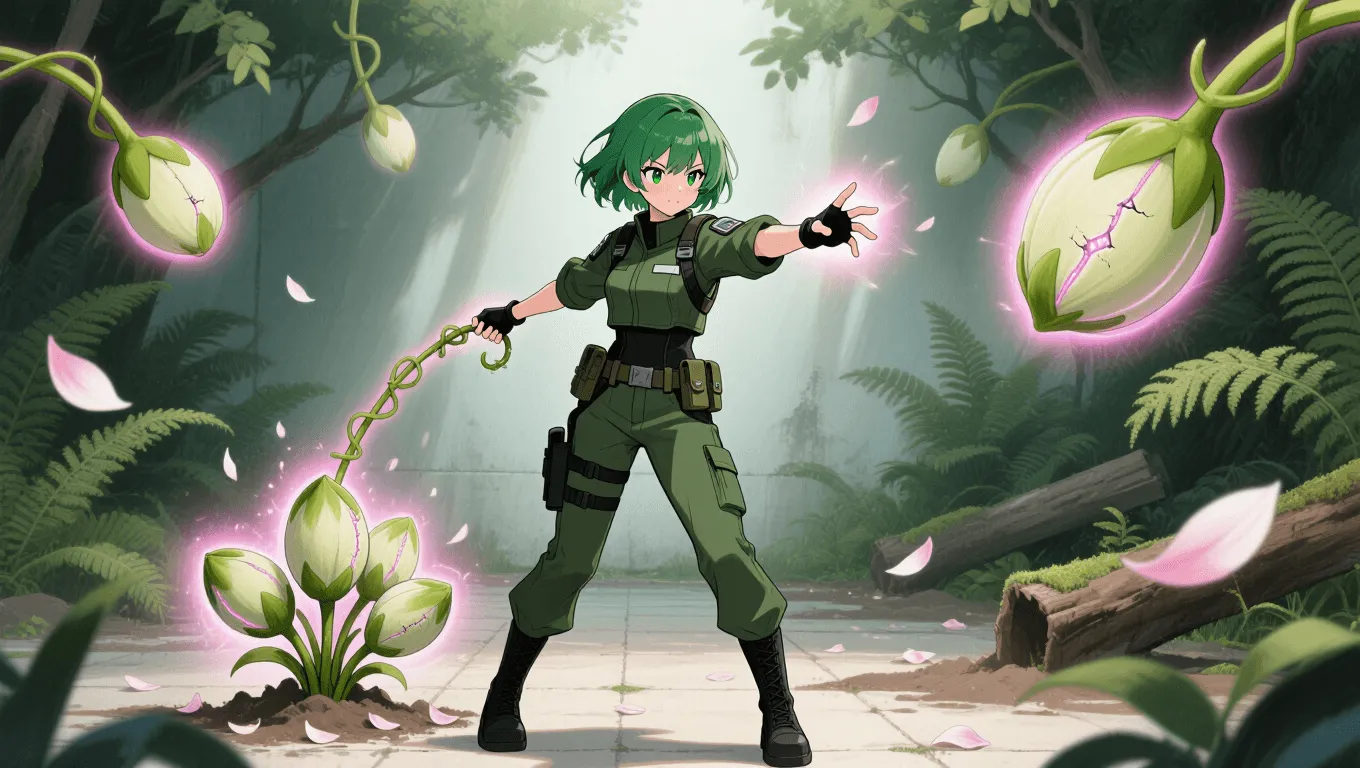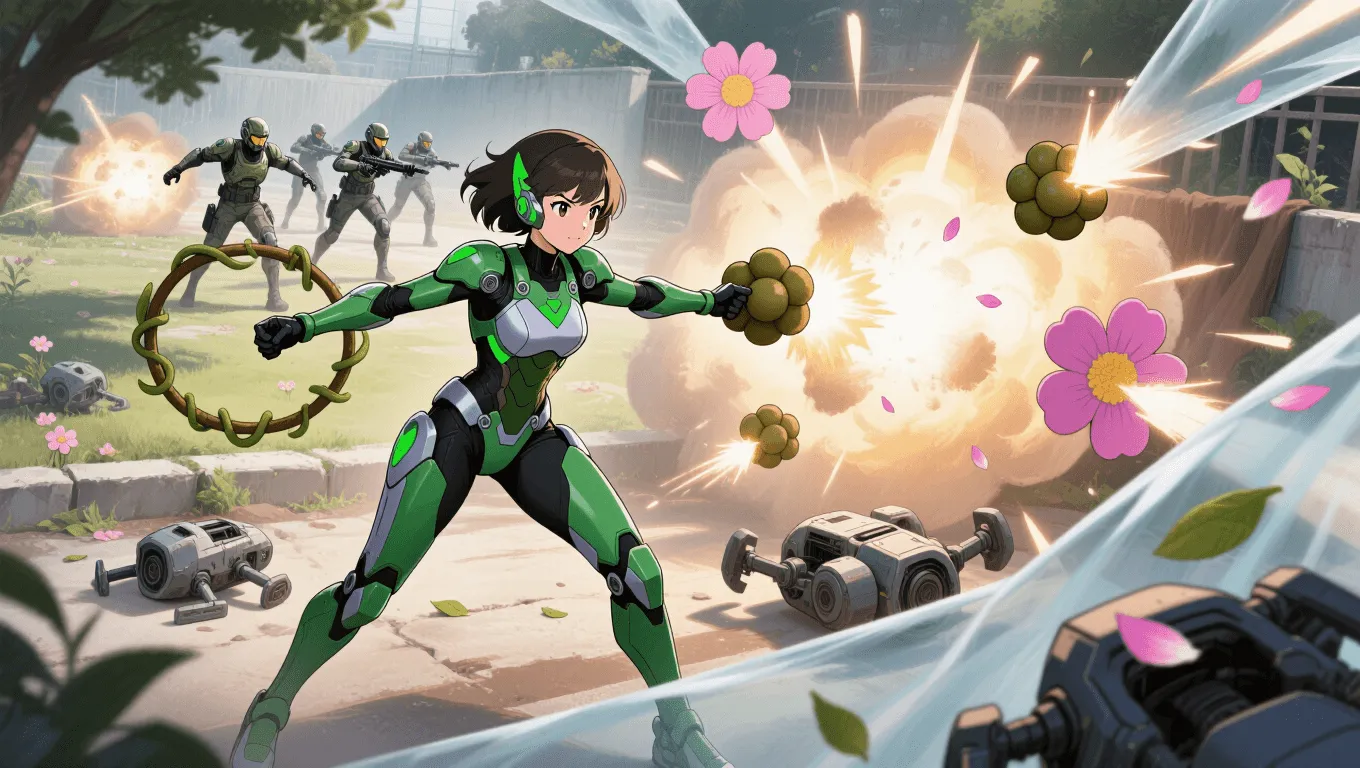Floral Explosion

Floral Explosion Video Demo 🎬
Table of Contents
What Is Floral Explosion
Floral Explosion is a plant-based combat ability where a user grows, shapes, and detonates botanical matter—typically blossoms, seed pods, or vine-grown pods—into controlled, high-yield bursts. Practitioners generate “flower bombs” that can stun, blind, concuss, or fragment into petal shrapnel. Unlike general plant manipulation or chlorokinesis, Floral Explosion focuses on rapid growth and timed detonation of organic charges. Common variants include blossom detonation, pollen burst, seed bomb projection, and explosive plant growth. For more abilities like this, browse the list of superpowers or roll a new idea with the random superpower generator.
Core Abilities of Floral Explosion
Concussive Bloom
Users cultivate compact blossoms or pods and trigger a controlled overpressure burst. These “botanical bombs” act like non-metal grenades—ideal for breaching and crowd control with reduced ricochet risk.
Petal Shrapnel
Hardened petals or thorny bracts fragment on detonation, creating a short-range cone or radial spray. Petal shrapnel excels at disabling lightly armored foes and severing ropes, wires, or exposed tubing.
Pollen Flash-Bang
Bright bioluminescent pollen bursts produce a flash and pressure pop, disorienting enemies while releasing irritant or soporific spores. This enables area denial without lethal force.
Seed Bomb Fabrication
The user can “prime” toughened seed pods, then plant or throw them as delayed charges. Seed bombs double as traps when buried near chokepoints or doors.
Vine-Propelled Charges
Vines whip or sling explosive blossoms with surprising accuracy. Advanced users thread charges through foliage like a living mortar line.
Targeted Bloom Geometry
Explosions can be shaped via petal arrangement—ring-shaped blasts for safe-center breaching, or directional cones to protect allies behind the user.
Aroma & Chemical Tuning
Some practitioners modulate flower chemistry to add smoke, adhesive resin, soporific gas, or corrosive sap to the detonation, blending sensory warfare with kinetic force.
Self-Replenishing Ammunition
With sufficient sunlight, water, and soil nutrients, users regrow ammunition rapidly, cutting logistical needs during prolonged engagements.
Environmental Amplification
Existing flora becomes raw material: hedges, weeds, and tree flowers can be coaxed into explosive blossoms, multiplying options in parks, forests, or overgrown ruins.
Application / Tactical Advantages in Combat
-
Breach & Clear: Concussive blooms open boarded doors or thin barriers while limiting shrapnel rebound typical of metal fragmentation.
-
Mobility Denial: Seed bombs placed along corridors, stairwells, and alleys deter pursuit or funnel enemies into killboxes.
-
Non-Lethal Crowd Control: Flash-bang pollen mixes stun, blind, or irritate without permanent harm—useful for captures or urban peacekeeping missions.
-
Stealth & Deception: Aroma-rich smoke blooms mask scents, conceal movement, or spoof tracking animals and scent-based sensors.
-
Anti-Drone & Anti-Sensor: Petal shrapnel disrupts rotors and exposed optics; sticky resin bursts fog lenses and vents.
-
Terrain Control: Vines deliver charges around corners or up vertical surfaces, enabling three-dimensional combat in dense terrain.
-
Sustained Operations: Renewable, regrowable ammunition reduces reliance on conventional supply chains.
-
Psychological Impact: The sudden transformation of harmless flowers into precise detonations creates shock value that can break enemy morale.
Level: Level 1 🏙️, Level 2 🌇, Level 3 🌃
Level 1 — Budding Detonator
-
Range: 5–10 meters throw or vine-assisted placement.
-
Yield: Stun-level concussions; minor petal fragmentation effective within a small room.
-
Control: Basic timing (instant or short delay).
-
Focus: Needs nearby plant matter or pre-grown pods; growth is slow in nutrient-poor zones.
-
Use Case: Distraction, escape, non-lethal disorientation.

Level 2 — Garden Bombardier
-
Range: 15–25 meters with vine propulsion; limited arc shots over cover.
-
Yield: Room-clearing bursts; petal shrapnel can penetrate light materials (cloth, leaves, thin plastic).
-
Control: Shaped charges; two-stage pollen-then-concuss combo; safe-lane geometry to shield allies.
-
Throughput: Can maintain a steady cadence of seed bombs; moderate regrowth between skirmishes.
-
Use Case: Breaching, area denial, anti-drone, coordinated squad tactics.

Level 3 — Floral Artillery
-
Range: 40+ meters via vine catapulting and seed-pod mortars; precision placement through foliage networks.
-
Yield: Structural breaching on reinforced doors; tailored chemical payloads (sleep, adhesive, caustic).
-
Control: Microsecond timing, programmable multi-bloom chains, and environmental amplification using wild flora.
-
Throughput: Near-continuous bloom generation in optimal conditions (good light, water, nutrients).
-
Use Case: Siege actions, battlefield shaping, multi-lane denial, synchronized detonations across a block or tree line.

Limitations of Using the Floral Explosion
-
Resource Dependence: Optimal performance needs water, sunlight, and nutrient access. Arid deserts, sterile corridors, or salt-soaked decks reduce growth speed and blast potency.
-
Line-of-Sight & Biomass: Without nearby biomass, users must carry pods or take time to grow them, risking exposure.
-
Weather Sensitivity: High winds scatter pollen and reduce precision; heavy rain waterlogs blooms, dampening blast efficiency.
-
Chemical Backfire: Irritant or soporific payloads can affect allies if not carefully shaped or ventilated.
-
Thermal & Cryo Stress: Extreme temperatures can wilt, crack, or prematurely trigger pods, forcing careful storage and timing.
-
Signature & Counter-Forensics: Floral scents, colored pollen, and botanical residues are traceable; investigators can follow bloom chemistry back to a user’s “garden.”
-
Mental Load: Shaping, timing, and tuning chemical payloads require high concentration; fatigue increases misfires.
-
Friendly-Foliage Risk: Explosions amid dense allies’ cover (sandbags wrapped in vines, wooden barricades) can create secondary hazards.
Weakness Against What Other Superpowers
-
Cryokinesis / Cold Manipulation: Freezes moisture in blossoms, cracking cellular structures and preventing proper detonation.
-
Pyrokinesis / Heat Manipulation: Scorches or prematurely ignites pods, burning away volatile compounds and destroying precision shaping.
-
Hydrokinesis: Saturates blooms to suppress ignition; pressure jets strip petals before detonation.
-
Aerokinesis / Vacuum Control: High winds disperse pollen clouds; localized vacuum starves combustion-like reactions and collapses blast geometry.
-
Metal Manipulation / Magnetokinesis: Armored foes with metallic plates shrug off petal fragmentation; metal baffles easily redirect organic shrapnel.
-
Toxin Immunity / Bio-Filter Auras: Neutralize irritant and soporific pollen, blunting the non-lethal edge of Floral Explosion.
-
Severing Telekinesis / Force Barriers: Pushes or encapsulates blooms mid-flight, isolating or detonating them safely away from targets.
-
Geo-Sealing (Terrakinesis): Rapidly buries planted seed bombs, forcing the user to waste charges or reposition.
Synergistic Power Combos
-
Chlorokinesis / Plant Manipulation: Rapidly grows high-density blossoms, roots, and vines to mass-produce charges and create instant delivery networks.
-
Aromakinesis / Pheromone Control: Tunes post-blast scents for confusion, fear, or calm—stacking psychological warfare with kinetic shock.
-
Aerokinesis: Carries pollen flash-bangs across angles, creates negative-pressure corridors to keep irritants off allies, and steers petal cones midair.
-
Terrakinesis: Shapes planter berms, root channels, and protective earthworks for safe-lane detonation and modular siege setups.
-
Photosynthetic Energy Conversion: Supercharges growth cycles, shrinking recharge time between volleys.
-
Illusion Casting / Light Manipulation: Masks pod placement with holographic foliage or dazzles targets just as pollen bursts trigger.
-
Hydro-Threading: Uses fine water filaments inside petals to enhance fragmentation patterns on detonation.
-
Bio-Armor: Grows shock-absorbing floral plating for the user and allies, enabling close-quarters detonation without injury.
Known Users
-
Poison Ivy (Pamela Isley), DC Comics — A master botanist who manipulates plant life at will; many depictions show explosive blossoms as an extension of her arsenal. Character profile
-
Black Tom Cassidy, Marvel Comics — Channels and controls plant life; certain portrayals feature botanical bursts through woody growth and vine weapons. Character profile
-
Floronic Man (Jason Woodrue), DC Comics — A plant-hybrid intellect who weaponizes flora; explosive bloom tactics appear in several storylines. Character profile
-
Original RPG Archetypes:
-
The Grenadier Gardener — Urban tactician specializing in seed bombs and aerosol pollen flash-bangs.
-
The Orchard Sapper — Siege expert using vine-propelled charges and earth-buried pods to control approach lanes.
-
The Bloom Artillerist — Long-range specialist coordinating multi-bloom salvos through forest canopies.
-
Explore more abilities and counters in the superpower wiki, or discover a fresh concept with the random superpower generator.
